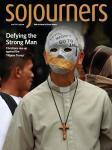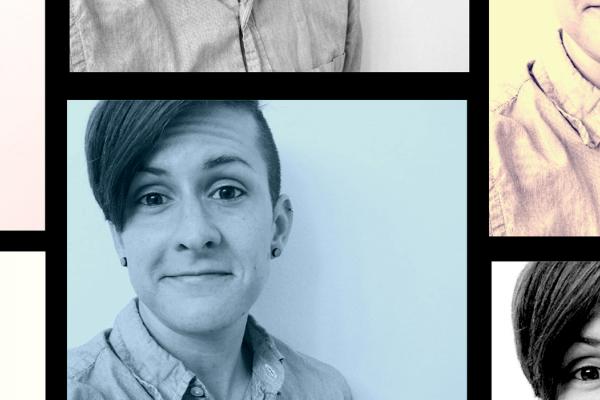"I can’t fathom trying to do this without my faith.” For M Barclay, currently on the path to ordination, faith has never been the problem. For Barclay, the biggest barrier to Christian life hasn’t been belief, science, secular culture, or even their own gender identity. The stumbling block, at every point, has been the church.
Like many transgender Christians, Barclay has been told that their gender identity is sinful, that their faith is not valid, and that they should not be called to ministry or involved in Christian life unless they “repent.” (Barclay, who does not identify as strictly male or female and uses the pronouns “they” and “them” for self-reference, has intentionally chosen their name, M, for its gender neutrality.)
Whether we know it or not, transgender people are already a part of our church communities. As of 2016, at least 1.4 million adults in the U.S. identify as transgender, and 66 percent of trans people have been a part of a faith community at some point in their life. Unfortunately, 1 in 5 trans people of faith reported leaving their faith community due to rejection.
Still, some trans Christians find the strength to stay.
‘I prayed for God to fix me’
Nicole Garcia is one of these persistent people of faith. Growing up, Garcia was a good Catholic boy. As a teen, she went to Mass two or three times a week, and even sat on the parish council. At the age of 18, she discerned a call to the priesthood, but as the eldest son in a Latino family there were other expectations. So Garcia buried that call to ministry alongside the knowledge that she did not feel like the eldest “son” everyone told her she was.
“I had prayed so hard to God to try to fix me,” Garcia said of those early years. “I knew I didn’t fit into the roles that I was supposed to fit into.” As she got older, she tried to become the picture of manhood—got married, bought a house, went into law enforcement. But instead of finding happiness, Garcia ended up abusing alcohol and having suicidal thoughts. Finally, after a night that nearly ended in her death, Garcia reached out and got help. She found a therapist and explained her feelings, and how she had been wearing women’s clothing and presenting as female in private. The therapist recommended a support group for cross-dressers; there, Garcia heard about a conference put on by the Gender Identity Center of Colorado.
Garcia laughs now, remembering her experience. “I went into this conference feeling alone and I found a couple of hundred people who were just like me. I was amazed. It was incredible.” She happened to stumble into a workshop specifically about gender identity and transgender people, and, as she put it, “I heard my story spoken back to me.”
“As I’m sitting there in that workshop I finally realized that I was Nicole. I was a woman. It just became crystal clear, and a weight was lifted off my shoulders.”
As it turned out, Garcia not only found herself at the conference—she also met a new friend who was also transgender and also in law enforcement. One day Garcia told her friend that she was considering going back to church.
Garcia wasn’t sure how to find a community that would welcome her faith, her cultural identity, and her experiences as a transgender woman. Her friend from the gender conference suggested an LGBTQ-affirming Lutheran church in downtown Denver.
What's the difference?
- transgender - adj. A person whose gender identity does not correspond with the gender assigned at birth
- cross-dresser - n. A person who wears clothing commonly associated with the "opposite" sex
- cisgender - adj. Someone whose gender identity matches the gender assigned at birth
- nonbinary - adj. Not identifying as strictly male or female
- queer - adj. Formerly a pejorative, queer is often used as an umbrella term for people who identify outside of traditional gender and sexual identities
- gender identity - n. One person's experience of one's own gender, which may or may not correspond with the gender assigned at birth
Cut to the present, and Nicole Garcia is a candidate for ordained ministry in the Evangelical Lutheran Church in America and has worked for years with the Lutheran LGBTQ advocacy group Reconciling in Christ. She credits the Holy Spirit for all of this and sees her call spoken back to her in the story of Philip and the Ethiopian eunuch (Acts 8:26-39).
Garcia points out that in this story, Philip is sent down a road specifically for the purpose of meeting a person traveling from Jerusalem to Ethiopia—a person who was considered not quite male and not quite female. Eunuchs in biblical times lived as a sort of third gender: They were in-between people, not trusted in Hebrew society and not welcomed in the temple. But Philip is told by an angel to go to the wilderness road and get into the chariot with the eunuch reading scripture. After discussing an important passage from the book of Isaiah, the Ethiopian eunuch asks, “What is to prevent me from being baptized?” Philip’s only reply is to get into the water of a nearby oasis and bring this outsider—this person whose sex, gender, and racial and ethnic identity all fell out of bounds—into the body of Christ.
Garcia understands and holds this story in her heart and in her body, and that intimate knowledge influences her theology and ministry. Rather than getting caught up in the insider/outsider dynamic that so often hampers churches, Garcia recognizes that “this tremendous gift of grace has been given to all the world, and not to just one people. That’s the key—to recognize that the Word is not just for one type of person.” She has lived life from the perspective of the eunuch—seeking and finding love and acceptance—and now she lives life as one of Jesus’ disciples, telling others the good news and baptizing along wilderness roads.
‘This is who I am’
Barclay grew up in northwestern Florida, in a very conservative culture. Ironically, before coming out as transgender, Barclay was told that they could not become a leader in their evangelical church because of the gender at birth. “I tried to start the ordination process in high school but I was told ‘women can’t be ordained,’” Barclay explained.
Barclay moved away to college and became involved with the United Methodist Church, which holds more inclusive views about the ordination of women. Barclay came out as a lesbian, and although the road got rockier, a ministry position of some kind still looked possible. The deep introspection that theology requires helped Barclay to understand their own call. Working with other queer people of faith was broadening their horizons. Finally, Barclay couldn’t ignore it anymore.
“Once I realized, ‘Oh gosh, this is it. I’m nonbinary. There’s no question—this is who I am,’ I didn’t want to deal with it. It sounded awful. Everywhere I went I would have to teach people about something they think is nonexistent. I hate burdening people, and so the idea of asking people to use ‘they/them’ pronouns was just ... yuck. I didn’t want to have to deal with any of it, but I chose to deal with it because I’ve seen and experienced and believe in resurrection—even when people leave your life because they don’t agree with who you are, even when the social stigma feels unbearable, even when my place in the church has been threatened because of my identity. For me, the truth of resurrection is that life is gonna show up, in some way, some form, some fashion, and I trust that. My life has just proven that to be true.”
For Barclay, the liberating power of scripture is found even in verses often used against transgender people—such as “God created humankind in his image, in the image of God he created them; male and female he created them” (Genesis 1:27).
“All of Genesis 1 begins with binary language, and when you look at it, it’s kind of obvious that it’s meant to speak to all of creation,” Barclay explained. “It talks about night and day and land and water, but we have dusk and we have marshes. These verses don’t mean ‘there’s only land and water, and there’s nowhere where these two meet.’ These binaries invite us into thinking about everything between and beyond.”
A new name tag
Taj Smith didn’t grow up within the context of a Christian church, but he was incredibly curious about faith. He spent time studying Buddhism and Islam before finally joining a large evangelical church. By high school Smith was a regular at youth group, and he felt at home there—that is, until he came out as queer.
“I stopped going [to church] after a number of folks told me that it wouldn’t work with me being queer, and that I needed to pray harder, and all of those things that people say to queer folks,” Smith laughed. “So I was an atheist for a long time.”
In college Smith found a United Church of Christ community down the road from his campus and decided to give Christianity another shot. But it was around that time that Smith started thinking more deeply about his gender identity. After a period of discernment, Smith realized that he was transgender and decided to come out to his church.
“The first Sunday I went back to my church after I came out as trans, I just remember standing in front of the name tags and staring at mine and thinking, ‘I can’t put that on,’” Smith explained. The name on the tag no longer reflected who he really was.
“One of the greeters came up to me, and she says, ‘You need help finding your name tag?’ And she laughed, and I laughed, and I said, ‘No, I think I need a new one. I need a new one, like, forever.’ And she went, ‘Okay!’ And she got me a new tag, and she said, ‘Why don’t you write your name on this one and we’ll have a new permanent one for you next week!’ And she handed me an order of service and I went inside and thought, ‘That was the easiest thing ever!’ That church became a safe haven for me.”
Now, as Smith looks back on his life, “I say that my transition and my experience of religion in that church are inseparable. My faith and my gender identity are so linked for me that I don’t know how to talk about one without talking about the other.”
‘That’s what “abundant life” looks like’
For transgender Christians who have been out for several years, and who have been involved with Christian communities for longer, constantly focusing on biblical clobber passages can be exhausting. Apologetics has its place, but at some point there must be a movement toward a more holistic theology. In that spirit, Smith talked with me about John 10:10 and Jesus’ promise of abundant life for his sheep. Rather than merely protecting his sheep and assuring their survival, Jesus says he comes to assure that his flock thrives. What might it look like to see transgender people thriving in Christian communities?
As a black transgender man, Smith sees abundant life for folks like him in churches where people are valued for their entire being, rather than as part of a diversity quota.
“I find that there are churches I go to where I know people are talking to me because a) I’m a young adult, or b) because I’m black, or c) because I’m part of some other diversity initiative. But when people are just genuinely welcoming, and when people do their best to welcome you and situate you in the community as you are, that’s really what abundant life looks like. To have a community to come home to, and to be able to say, ‘Yes, I’m a part of that.’”
Being recognized as a child of God, and as part of the body of Christ, is something most Christians take for granted. For transgender folks, this recognition is hard to come by. Yet transgender Christians hold on to belief in a God that makes a way out of no way in a time when Christianity needs it most. Our lives and our experiences speak to God’s power at work in the world, and we can’t wait to share those stories with you, and to work alongside you in the service of the gospel.
Grim Stats
- 40 percent of transgender people in the U.S. attempt suicide in their lifetime (nearly nine times the national rate).
- More than half of U.S. transgender people (57 percent) say they feel uncomfortable asking police for help.
- In 2016, the Anti-Violence Project documented 23 homicides of transgender and gender nonconforming people in the U.S., the highest ever recorded by the coalition.

Got something to say about what you're reading? We value your feedback!

